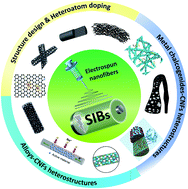Recent advances in electrospun one-dimensional carbon nanofiber structures/heterostructures as anode materials for sodium ion batteries
Abstract
As promising candidates for large-scale energy storage systems, sodium ion batteries (SIBs) are limited by their relatively lower energy density. This shortcoming necessitates the design of anodes with high specific capacity and excellent cycling durability, yet low cost. Here, we review one-dimensional structural/heterostructural carbon nanofibers (CNFs), which are generally synthesized via a simple, low cost, and scalable electrospinning technology, as a basis for developing anode materials for SIBs. The rational design in the structure and chemistry of CNFs, including construction of cross-link structures and porous structures as well as heteroatom doping, is described, followed by illustrations of how a robust understanding of CNFs as the carbon matrix within heterostructures provides fundamental insights into the electronic conductivity, electrochemical activity and cycling stability in anode materials with high theoretical capacities (alloys and metal chalcogenides). Based on the insights, we conclude the future perspectives on the critical issues, challenges and research directions in designing one-dimensional carbon nanofiber based materials via electrospinning.



 Please wait while we load your content...
Please wait while we load your content...